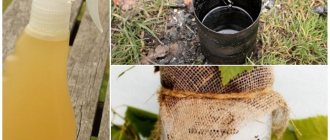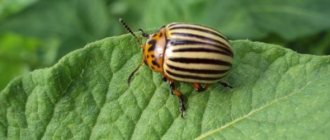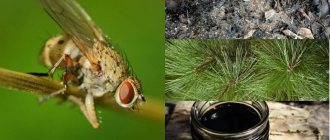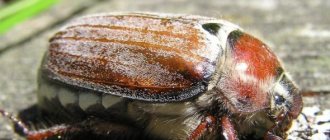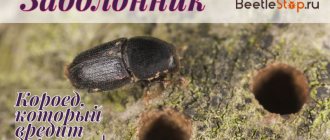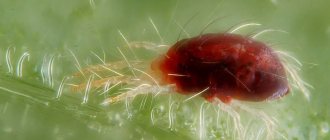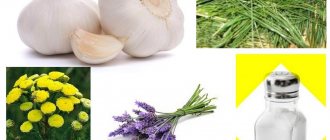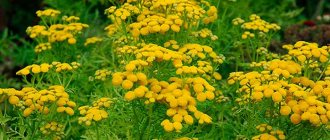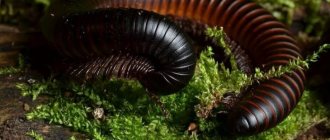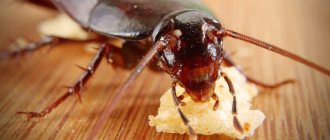- Bioactive substances
Every season, summer residents are faced with a huge number of pests that strive to destroy the crop, and in order to save the fruits of their labors, they look for possible ways to eliminate the parasites. A particularly pressing question is how to get rid of the Colorado potato beetle on potatoes forever.
But it is unrealistic to completely get rid of the Colorado potato beetle , and there are no means for this. The beetle is absent only where, over large areas, all plants of the nightshade family are completely absent, that is, not only potatoes, but also tomatoes, eggplants, peppers, physalis, etc.
The Colorado potato beetle is the worst enemy of gardeners. To save the harvest of potatoes and other vegetables, it is important to take timely emergency pest control measures
The article contains the most effective means of pest control, the effectiveness and safety of which are confirmed by numerous positive reviews from experienced gardeners.
Spraying
Treating potato tops with herbal infusions is an absolutely safe method for humans and the future harvest. In order for it to have the maximum effect on the pest, you will have to prepare the infusion right before spraying.
Most plants are suitable, including weeds.
Celandine
Take it whole, put it in a container and fill one third with water. Place on the fire, bring to a boil and simmer for 15 minutes. Cool, strain through two layers of gauze and dilute at the rate of 0.25 liters of broth per 5 liters of water.
Dandelion and horsetail
Pour 100 g of these plants into 5 liters of water. Boil and simmer for 15-20 minutes. Cool, strain and dilute at the rate of 0.5 liters of concentrated broth per 10 liters of water.
Sagebrush
Take 5 branches of wormwood, cut into small pieces, put in a bucket. Pour all 10 liters of boiling water and leave for 8-10 hours. Strain the finished infusion through a fine sieve.
Wormwood decoction should not be used often, because it slightly inhibits the development of the treated plant.
Tomato tops
Chop 1 kg of tomato tops and add 10 liters of warm water. Leave for 5 hours, then add 3 tbsp. l. liquid soap or 40 g of solid soap, mix everything thoroughly.
Infusion of herbs
Take 20 g of ground red pepper, 200 g of garlic stalks, 300 g of wormwood, 200 g of hemlock, 8 pods of hot pepper and ¼ piece of laundry soap, put in a bucket. Pour 10 liters of water over the herbs and leave for 12 hours, and then strain.
Honeysuckle tall
Dry the stems and leaves of honeysuckle. Fill the dry parts of the plant with water at the rate of 10 liters of water per 1 kg of grass. Leave for two days, then strain. Add 40 g of laundry soap to the resulting infusion and mix.
Spraying potato tops should be carried out on a windless morning, immediately after the dew has dried and at a temperature of 18-22°C. Repeat treatment every 5-7 days. Varieties of infusion need to be alternated, as the beetle quickly adapts to them.
Benefits of using folk remedies
Insecticides are convenient to use for two reasons. Firstly, a powerful dose kills the beetle outright. Secondly, the gardener likes the ease of use. It is enough to dissolve the product from the bag with water, pour it into the sprayer and you can treat the plantings. You will have to tinker a little with folk remedies to prepare them.
However, their advantage is that decoctions or infusions are made from natural raw materials. The absence of chemicals is safe for potatoes; the tubers do not accumulate toxic substances. In addition to folk remedies, the beetle has no adaptation. Decoctions, infusions, and traps operate annually. Insecticides need to be changed every season, since insects develop immunity to many chemicals.
Manual collection
An effective, but very labor-intensive method is manual destruction of the pest. It is suitable for small planting areas, because for a good result you will have to collect beetles daily.
To do this, take a large plastic bottle, cut off the top, pour kerosene or a concentrated soap solution into the bottom and collect beetles, larvae and leaves affected by the egg clutch.
Next, the contents are burned or left in the jar until the pests completely die out.
Description
The Colorado potato beetle is an insect with an oval, convex, shiny yellow-orange body 8-12 mm long, up to 7 mm wide with five black stripes on each elytra. The beetle has black spots on the dorsum, the membranous wings are well developed - the beetles are able to make long flights.
The Colorado potato beetle larva, 15-16 cm long, has a black head and two rows of black spots on the sides. At first, the body color of the larvae is dark brown, but over time it becomes bright yellow or pinkish - when eating leaves, the larvae are able to digest all pigments except carotene, which, accumulating in the tissues, colors the bodies of the larvae in a carrot color.
Colorado potato beetles overwinter in the soil at a depth of 20 to 50 cm, and in the spring they come to the surface, feed on seedlings, mate and lay eggs on the underside of leaf blades. One female can lay from 5 to 80 eggs per day, and from 300 to 1000 eggs per season. The larvae of the first instar feed on the pulp of the leaves from the underside, the larvae of the second instar destroy the entire blade, leaving only the midribs, and the larvae of the third and fourth instar spread, often moving to other plants.
- Cabbage armyworm: control and prevention
After 2-3 weeks, they burrow into the soil to a depth of 10 cm and pupate, and after 10-20 days they turn into an adult and come to the surface or, if late autumn has already arrived, enter diapause until spring.
The lifespan of Colorado potato beetles is one year, but some individuals can live two or even three years. If the beetles are in danger, they do not fly away, but fall to the ground, pretending to be dead.
Mixed plantings
Another reliable method of control is to plant crops that are lethal or hateful to the beetle between the rows of potatoes.
Recent Entries
Lilac perennials that are beautiful, compact and do not crowd out other plants Why when buying seedlings you should not take the sellers’ word for it and how to determine the age of the plant using 3 signs Tomato seedlings have turned purple or whitish: why the color has changed and how to save the plants
The most poisonous plant for this insect is fragrant tobacco. It is enough to plant it around the perimeter and between the rows at a distance of 1.5-2 m. The beetles will flock to the tobacco, start eating it and soon die. In subsequent years, when the concentration of larvae and beetles decreases, gaps of up to 5 m can be made between tobacco plantings.
It is important to take into account that it should be planted two months before potatoes, so that it has time to grow to 20-25 cm and attracts Colorado potato well.
Dill and matthiola bicorne are also effective. They smell so strong that they can scare beetles away from potatoes. They should be planted tightly - one dill or matthiola for two potato bushes. Scented marigolds, calendula, nasturtium, coriander and borage are also suitable.
Alternating rows of beans and potatoes helps. The beetle will be afraid to fly close. At the same time, both plants do not interfere with each other’s development and fruiting.
Safety precautions when working with drugs
Insecticides that are used to combat the Colorado potato beetle can cause harm to humans if used carelessly. Before treating potatoes for the Colorado potato beetle, you cannot ignore safety rules. They will protect themselves and others.
Be sure to do:
- Wear thick clothing that will cover all parts of the body.
- Use a mask and goggles.
- The drugs are diluted according to the instructions, after checking the expiration date of the drug.
- Tops are treated by spraying.
- You cannot mix different drugs in one treatment.
- To prevent the product from precipitating, the barrel with the solution is stirred periodically.
- After completing work on processing plants, thoroughly wash your hands, face, and wash clothes.
Naturally, when using chemical or biological preparations, you should not eat, drink, or smoke. After spraying, do not perform any other work on the site for several days.
Traps
Homemade baits will also help in the fight against pests. For maximum efficiency, it is good to combine them with manual collection.
The first method is fishing in a jar:
- take a liter jar, throw the tuber cut into pieces into it;
- bury the jar between the rows so that its neck is level with the surface of the bed;
- Rub the edges of the jar with a piece of potato - juice will remain on them.
The beetles will follow the smell and fall into the jar. The radius of one trap is 5 sq.m.
The second way is to place piles of peelings and chopped potatoes around the perimeter of the bed. The colorados will gather on the bait, and destroying them will not be difficult. This trap should be updated every 2-3 days.
Is it possible to poison the Colorado potato beetle during flowering potatoes?
At the moment of flowering, the tubers begin to actively form, so chemicals against insects should absolutely not be used. Bug protection is necessary, but it is better to use safe products or collect pests by hand.
Traditional methods are quite suitable for exterminating pests, but if some of the beetles still remain, they must be collected by hand and ensure that there are no clutches on the leaves. When collecting beetles, you need to place them in a bucket of saline solution.
During the flowering period, it is also allowed to use safe biological preparations. For example, Fitoverm and Akarin fight such pests well.
And if these remedies are alternated with each other and combined with folk methods, then the beetles will quickly leave the potato bushes.
Plowing
Closer to cold weather, the larvae go deeper into the ground and wait out the winter there. Some of them try to hide in the tops left after harvesting. Therefore, all vegetation should be burned and the area should be dug up.
Autumn plowing before frost will bring the larvae to the surface and they will die. This means that next season there will be much less pests.
A little history
The malicious beetle comes from North America. Until a certain time, it did not cause any particular problems for rural workers, until at the end of the 18th century it destroyed a significant part of the potato crop in Colorado. Since then they began to call it Colorado.
The striped fish was brought into Europe several times and was immediately destroyed, so it could not immediately take root. This happened in the 40-50s of the 20th century, when the insect still managed to gain a foothold and gradually take over agricultural areas. The enemy advanced quickly, brazenly and everywhere, and attacked not only potatoes. Peppers, tomatoes, eggplants and other nightshades are also under threat.
Many years have passed since that time, and today striped bugs and their red larvae on the leaves of potato bushes no longer surprise anyone. They, unfortunately, have become an integral part of our gardens. In Ukraine, in the city of Dnieper, a monument to the pest was even erected by order of one of the stores specializing in seeds. A huge Colorado potato beetle, happy with life, sits on potato leaves. It's a pity that the author of this stone sculpture didn't give him a return ticket to North America.
Modern methods of destruction
There are already potato varieties that are not attractive to insects. The varieties “Kamensky” and “Nikulinsky” are practically not susceptible to infection; they have hard stems and tops that are unsuitable for eating by larvae, but in terms of taste they are much inferior to less resistant varieties.
Breeders and scientists are trying to develop genetically modified products that will not become the target of parasites, but there is still too little information about the effect of introduced genes in the human body. The attitude towards GMOs in society is mostly negative precisely because of the lack of verified and reliable information about the consequences of eating another revolutionary development by scientists.
It is for these reasons that the war for the nightshade crop continues every season. To permanently get rid of pests on potatoes, using only one method is not enough. An integrated approach is required over a long period of time, even more than one year. Perhaps one day there will be a new, universal way to get rid of insects, but for now gardeners can only dream about this and fight the Colorado potato beetle with all available means.
What harm can it do to potatoes?
Adults and larvae intensively eat potato leaves, as a result of which the supply of nutrients to the plant and the formation of tubers are disrupted.
Colorado beetles are very voracious; they can destroy the entire potato crop, which is their main and favorite food product. In the spring, the beetles eat fresh foliage, in mid-summer - flowers, and later they can switch to tougher leaves and potato tubers.
The beetle overwinters so deep in the soil that even digging up the beds cannot harm it.
